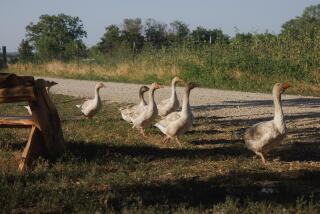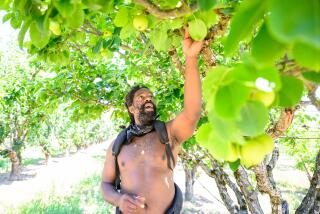Reckoning the Earth : FARM <i> by Grant Heilman (Abbeville Press: $45; 287 pp.; 0-89659-6) </i>
- Share via
“Have you reckoned a thousand acres much?” asked Walt Whitman in “Leaves of Grass.” “Have you reckoned the earth much?”
With his third book, “Farm,” writer and photographer Grant Heilman can answer a hearty, Whitmanesque “yes” to both questions. To put this prodigious book together, Heilman has traveled extensively in the agricultural regions of America, observing, interviewing, steeping himself in what farmers do and the land they do it on. The results are both impressively factual, to answer Whitman’s first question, and poetic, to answer his second.
Indeed, as with “Leaves of Grass,” there is no other book quite like it. “Farm” attempts, on the whole successfully, to give an overview of the crises, triumphs and trends of American agriculture, to suggest the diversity and character of farmers, and to detail with loving authenticity the way each agricultural product is grown or raised, and marketed. A generally admiring, broad-stroked portrait of farming in America, it is also critical at times of agrarian greed and narrow self-interest, and serves up thousands of small details that stick to the brain like mud to the boots. Readers will learn, for example, that grape growers normally prune “about 90 percent of each year’s growth” in a vineyard, an enormous task. We also learn that in one year “a single dairy cow eliminates more than 25,000 pounds of excrement. If a farmer is milking, say, 50 cows, he has to dispose of 625 tons of manure.”
Such details hardly enhance the prevailing romantic image of farming among non-farmers, but--at least in the prose--Heilman is a stickler for verisimilitude. The text is, however, accompanied by 200 or more photographs in gorgeously lush color, the majority taken by Heilman, and many of these create a consistently rosier mood about farm life than most farmers experience, or Heilman describes. While conveying the undeniable splendor of life on the land, in a curious way the photographs, at their most glamorous, cut against the grain of Heilman’s prose.
But “Farm” remains, without question, the best single source available for readers wanting a crash course in the varied arts of American farming. Farmers who grow some of the crops described are likely to learn a great deal about other crops and other farmers. While urban readers will have a smorgasbord of information spread before them about the sources of their diet. A good read, here, can be had by all.
More to Read
Sign up for our Book Club newsletter
Get the latest news, events and more from the Los Angeles Times Book Club, and help us get L.A. reading and talking.
You may occasionally receive promotional content from the Los Angeles Times.








